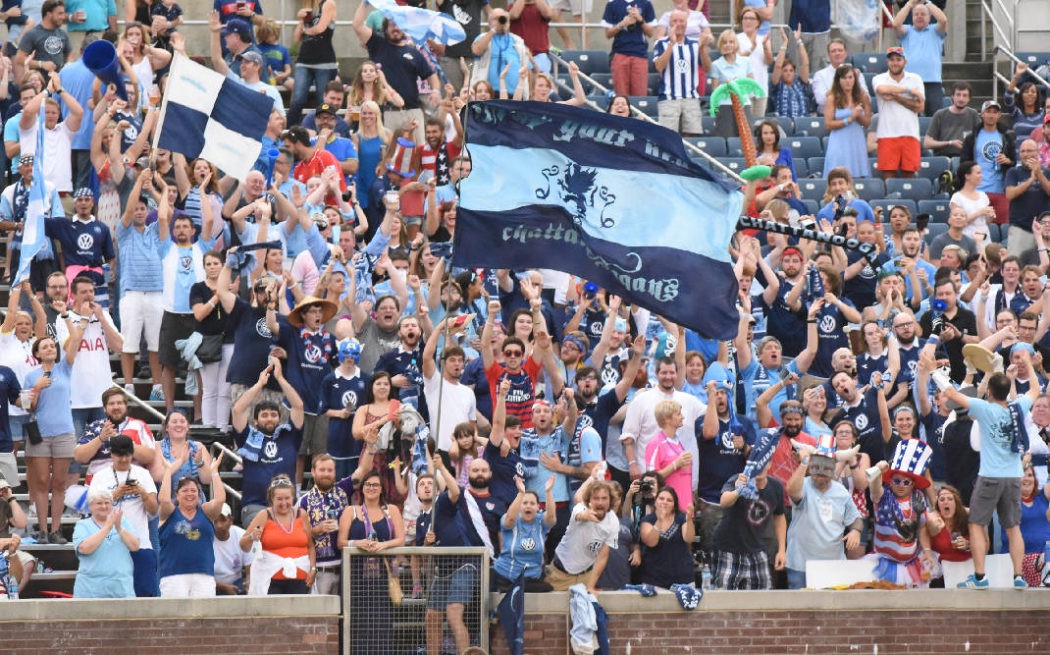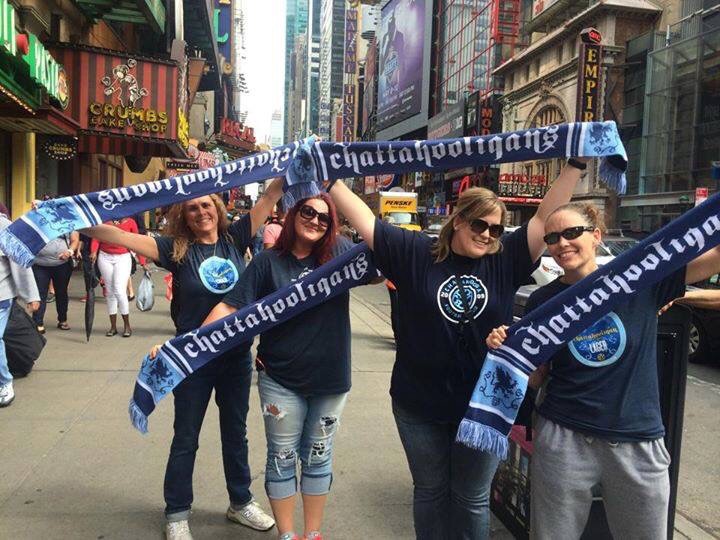
Earlier this month, Sean Reid wrote a lengthy piece for Howler about the NPSL’s Chattanooga FC, a club that is defying the odds of the league. This piece highlights one more reason Chattanooga is so distinctive.
For the Chattahooligans — a supporters group for a fourth division club that’s merely seven years old — there have been no growing pains in terms of gender equality.
From its founding members, including Elizabeth Spencer and Beverly McDaris, women have been at the forefront of the group since Chattanooga FC played their first minute, and their presence has only continued growing since. During matches, the literal front line of the supporters’ section is comprised of the “Front Row Vixens,” a bunch of soccer riot grrrls who arrive first at the tailgates, help lead the march to the match, and are “some of the loudest fans in the bunch,” according to Chattahooligan member Megan Hollenbeck. Also in the spotlight are individuals like Madonna Kemp, who describes herself as a “super supporter” and is described by Hollenbeck as “one of the most loyal fans” of either gender.
The amount of prominent women in the group coupled with the sheer amount of women in general — a group Social Hour event last year was attended by more women than men — also makes the Chattahooligan community acutely aware of the need to preserve a wholly welcoming space for all its members. This hasn’t seemed to be difficult; Hollenbeck remembers one instance in which a male crowd member who was calling an opposing player a “pussy” quickly “apologized and went about his business” as soon as she told him they “don’t use that word here.”
Adds member Shelly Ayers, “I feel fortunate to be part of a group in which the men value inclusion and equality. When I was younger soccer was such a male dominated sport, so to be a part of a group in which the men and women all come together as complete equals is amazing.
“We are encouraged to use our voices and express our opinions, we have helped organize events for our club and supporters’ group, and we’ve helped capo,” not to mention Kemp’s work as unofficial team videographer for the past five years. “It has been crazy to see this become something bigger than ourselves.”
Because of the fact that American soccer — both fans and clubs — has not always been known to treat women particularly well, and the fact that, according to Ayers, “in the south especially there seems to be that aura of traditional gender roles,” perhaps what is most impressive is the ease with which the Chattahooligans have achieved this “complete” equality. The women simply showed up for any sort of reason, from Ayers’ “urging [from her] friend and coworker” to Kemp’s desire to find an inexpensive and family-oriented activity for her and her kids, and then stayed and stayed because of how welcomed and comfortable the group made them feel.
And it helps that the women’s fanhood, all in all, has always defined them more than their womanhood.
“We yell for our boys on the field just as loud as the fellas in the group and we are unapologetic about our love for the sport, our club, and each other,” Ayers says. But, of course, no Chattahooligan would ask them to apologize.

In fact, the group’s inclusivity was such a naturally occurring phenomenon that the supporters didn’t realize it was not the norm until they got word of Fusion’s coverage of sexism in the American Outlaws. Galen Riley, a male member of the Chattahooligans, also remembers realizing around that time that “compared to [his] image of a typical supporters’ section from [his] previous experience at national team matches, [the Chattahooligans] had a ton of women in [theirs].”
Out of this sudden realization of how differently other groups operate emerged what Hollenbeck refers to as “a sort of unexpected initiative”: the Chattahooligans’ “We Stand For” hashtag campaign on Twitter and Facebook. The point, Hollenbeck continues, was to “outright separate [the Chattahooligans] from the trend pretty prevalent in other fan cultures that [is] unfriendly towards women” and other groups that do not always find themselves readily included.
“We stand for doing the right thing,” the group’s posts all ended. “It’s not just a code of conduct, it’s a priority.” Supporters eagerly chimed in with support of the campaign as well as their own posts on what they, as Chattahooligan community members, stood for too.
But the group’s success in terms of gender equality hasn’t bred complacency to other ways they can grow. As a highly controversial New York Times Magazine article recently tried to point out, divisions within American soccer aren’t only along gendered lines; racial and ethnic minority groups often find themselves on the fringes of supporters’ groups, too. It is in that sense, admits Riley, that they “still have opportunities to improve diversity.” And it is already something they “are working on authentic ways to achieve.”
Ironically, what helps those efforts be so authentic is the same thing that can hurt NPSL clubs in other ways: the smaller-scale front office. Far from the big-budget, highly-staffed departments that power the teams in Major League Soccer, the NPSL runs, Riley quips, “on folks’ evenings and lunch breaks.” Much of the planning and execution of outreach to future Chattahooligans, then, is done directly by the Chattahooligans themselves — but who better to attract others to a club than those who love it the most? Who better to welcome new supporters than the supporters themselves?
And slowly if not surely, the Chattahooligan driven efforts seem to be working. A little while after one of the group’s ticket giveaways to a minority school in the area, Riley was flagged down by a Latino student who had gotten one of the tickets and who planned to return to future matches.
Wednesday’s match versus the Tigres reserves also presented an opportunity to attract future Chattahooligans. “They do this every few years and there is always a temporary boost in attendance from the regional Latino population,” Riley explains. But “they key is getting them to come back.”
To help aid this, the Chattahooligans rotated some additional Spanish language chants into the supporters’ section routine during the game, and bilingual Chattahooligans set out to meet and greet the Tigres fans. And it’s not so far off to believe that this kind of adaptive outreach will get some of them coming back; after all, Ayers muses, “My love of soccer drew me to Chattanooga FC, but the community is what made me stay.”
Follow Gaby Kirschner on Twitter @GabyKirschner.
